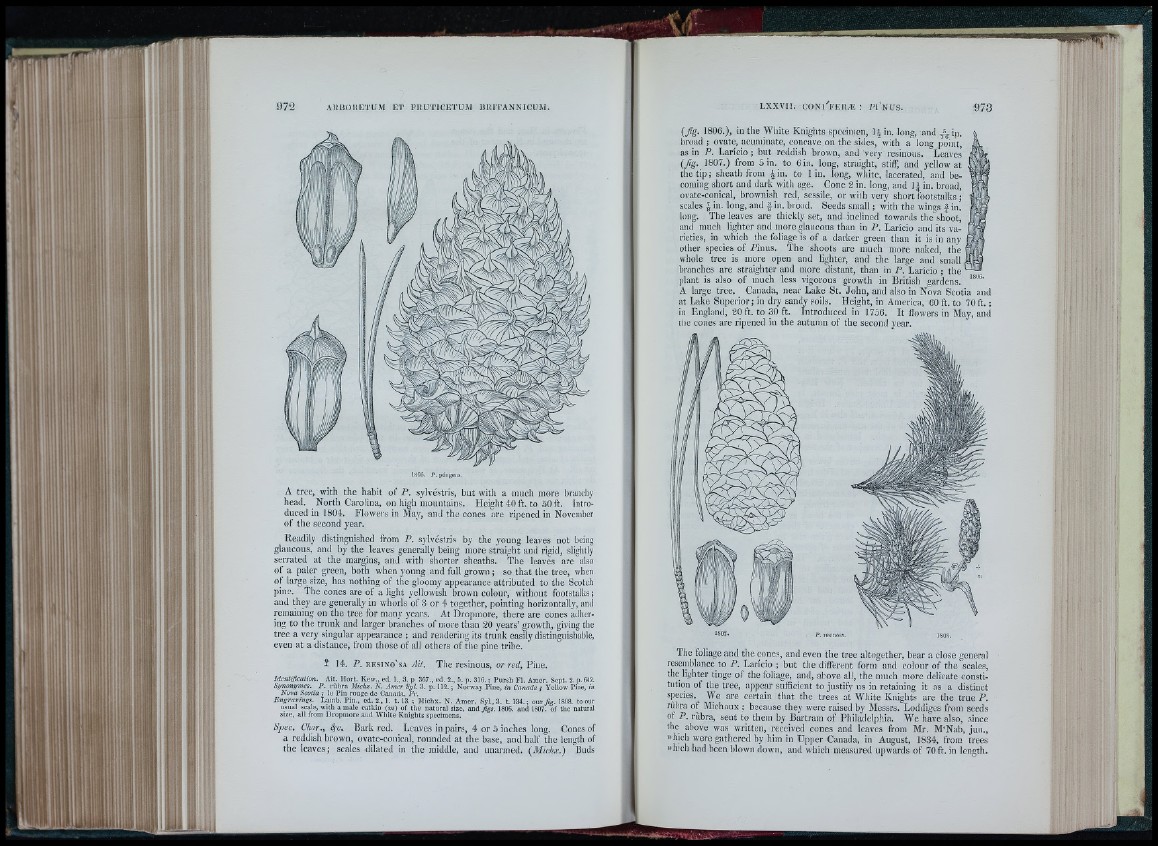
f ' u . - .. L
97-2 A R I iO U E T U M E T F R U T IC E T U M l i l l lT A N N IC U M .
1S05. P . püiigeiis.
A tree, with the habit of P. sylvéstris, but with a much more branchy
head. North Carolina, on high mountains. Height 40 ft. to 50 ft. Introduced
in 1804. Flowers in May, and the cones are ripened in November
of the second year.
Readily distinguished from P. sylvéstris by the young leaves not being
glaucous, and by the leaves generally being more straight and rigid, slightly
serrated at the margins, and with shorter sheaths. The leaves are also
of a paler green, both when young and full grown ; so that the tree, when
of large size, has nothing of the gloomy appearance attributed to the Scotch
pine. The cones are of alight yellowish brown colour, without footstalks;
and they are generally in whorls of 3 or 4 together, pointing horizontally, and
remaining on the tree for many years. At Dropmore, there are cones adhering
to the trunk and larger branches of more than 2 0 years’ growth, giving the
tree a very singular appearance ; and rendering its trunk easily distinguishable,
even at a distance, from those of all others of the pine tribe.
¥ 14. P. RESiNo'sA y///. The resinous, o r j’ci/, Pine.
Ideniification. Ait. Ilo rt. Kew., ed. 1., 3. p 3C7., ed. 2., 5. p. 316. ; P ursh Fl. Amer. Sept. 2. p. 642.
Synonymes. P. rùbra iVi'cAa:. A', .riiiwer 3. p. 112. ;I T’’Norway - Pine, in Canada ; Yellow "
Pine, f«
Nova Scotia ; le Pin rouge de Canada,
Fr.
Engravings.13,;Michx.N. Amer. Syl., 3. t. 134.; o u r /g . 1808. to our
Engravings. Lamb. Pin., ed. 2., 1. t. li. , .......... ...........
usual scale, with a male catkin (m ) of the natural size,
size, all from Dropmore and White Knights specimens.
Spec. Char., Bark red. Lcaves in pairs, 4 or 5 inches long. Cones of
a reddish brown, ovate-conical, rounded at the base, and half the length of
the leaves; scales dilated in the middle, and unarmed. (Mic/w.) Biuls
T
Z...X „ 1806. and 1807. of the natural
L X X V I I . C O N i T 'E H Æ : f i ' n u s . 9 7 3
(Jig, 1806.), in the White Knights specimen, ] i in. long, and
broad ; ovate, acuminate, concave on the sides, with a long point,
as in P. Laricio ; but reddish brown, and very resinous. Leaves
(fig. 1807.) from 5 in. to 6 in. long, straight, stiff, and yellow at
the tip; sheath from ^m . to lin . long, white, lacerated, and becoming
short and dark with age. Cone 2 in. long, and I f in. broad,
ovate-conical, brownish red, sessile, or with very short footstalks ;
scales f in. long, and f in. broad. Seeds small ; with the wings f in.
long. The leaves are thickly set, and inclined towards the shoot,
and much lighter and more glaucous than in P. Laricio and its varieties,
in which the foliage is of a darker green than it is in any
other species of Pinus. The shoots are much more naked, the (
whole tree is more open and lighter, and the large and small J
branches are straighter and more distant, than in P. Laricio ; the
plant is also of much less vigorous growth in British gardens.
A large tree. Canada, near Lake St. John, and also in Nova Scotia and
at Lake Superior; in dry sandy soils. Height, in America, 60 ft. to 70 ft. ;
in England, 20 ft. to 30 ft. Introduced in 1756. It flowers in May, and
ihe cones are ripened in the autumn of the second year.
The foliage and the cones, and even the tree altogether, bear a close general
resernblance to P. Laricio ; but the different form and colour of the scales,
the lighter tinge of the foliage, and, al;ove all, the much more delicate constitution
of the tree, appear sufficient to justify us in retaining it as a distinct
species. Ws ai’e certain that the trees at M^hite Knights are the true P.
rubra of Michaux ; because they were raised by Messrs. Loddiges from seeds
of P. riibra, sent to them by Bartram of Philadelphia. We have also, since
the above was written, received cones and leaves from Mr. M‘Nab, Jun.,
which were gathered by him in Upper Canada, in August, 1834, from trees
which had been blown down, and which measured upwards of 70 ft. in length.